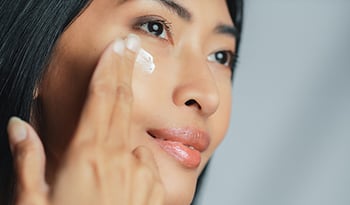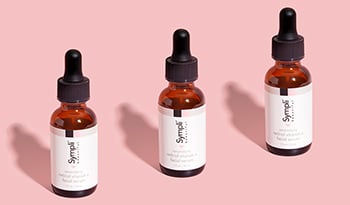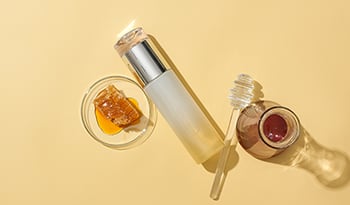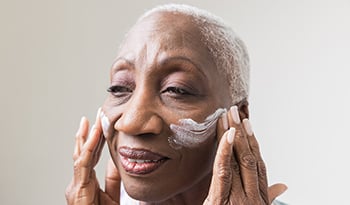This Popular Ingredient Is Probably In Your Skincare Products: Here’s Why
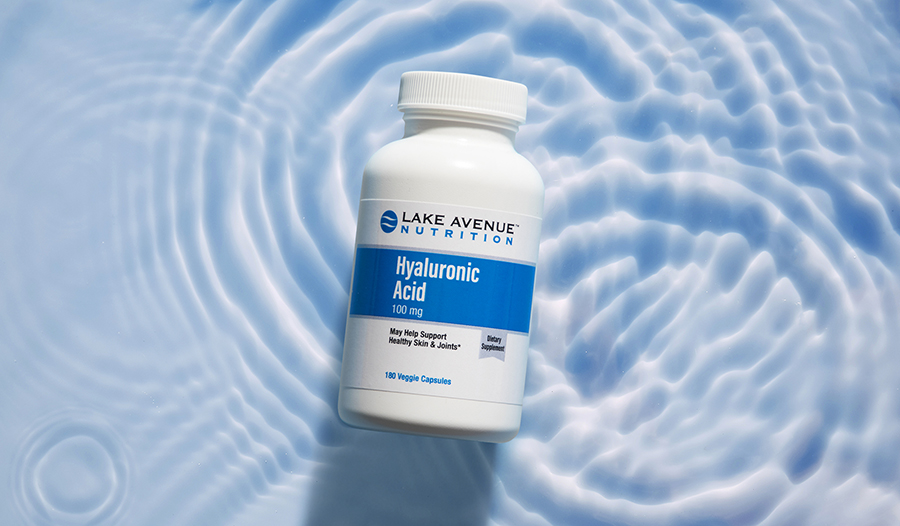
What is Hyaluronic Acid?
Hyaluronic acid is an ingredient in topical, oral, and injectable healthcare products. Composed of long chains of sugar molecules that contain repeating units of the two sugars D-glucuronic acid and N-acetyl-D-glucosamine, hyaluronic acid is produced throughout the body as a structural component. In addition, hyaluronic acid holds large quantities of water, hydrating and lubricating both skin and joint tissues.
Why Is Hyaluronic Acid Used in Skincare Products?
Throughout the connective tissue of the body, hyaluronic acid is fairly rapidly produced and broken down. Molecules of hyaluronic acid in the skin typically don’t last longer than a day before they are replaced. Throughout the cartilage of the body, hyaluronic acid may last up to a few weeks before it degrades.
As we age, less hyaluronic acid is produced, especially in the skin. This loss of hydration is a major contributing factor to skin aging, decreasing elasticity and promoting atrophy. This damage eventually leads to wrinkles, loss of skin tone, and sagging skin.
As such, the high level of interest in hyaluronic acid is not surprising due to its potential for improving skin health and decreasing the signs of aging. However, research suggests that the molecule has potential for other uses as well.
Photoaging: Skin Damage from Sunlight
Sunlight is one of the most significant causes of premature skin aging. Estimates suggest that up to 80% of skin aging is due to sun exposure. In mice, just 5 minutes of sunlight was shown to induce changes in hyaluronic acid levels indicative of damage. Over the long term, sun exposure leads to a process similar to scar formation throughout the affected skin with reductions in hyaluronic acid levels.
While it’s still worth considering reasonable sun exposure to increase vitamin D levels, it might be best to focus on the exposure of the arms and legs rather than the head and neck to limit photoaging effects on the face. Using safer, nonchemical sunscreens may also help limit photoaging due to sunlight exposure.
Hyaluronic Acid as an Injectable Skin Filler
Anti-aging treatments have become quite popular. Botox and skin fillers are common treatments people utilize to try and look younger. One use of hyaluronic acid is as an injectable skin filler to plump up tissues. While the practice has garnered a considerable following, it’s worth exploring its efficacy and acknowledging reported side effects.
While typically considered safe, skin fillers can be associated with side effects, some of which can be severe. One study on tear trough deformity, a condition where the fat bags around the lower eyelid near the bridge of the nose become more prominent, found a concerning level of side effects with injectable fillers, including hyaluronic acid.
Delayed reactions included swelling in close to half of recipients. One in 4 individuals reported lumps or nodules after treatment, and xanthelasma: a condition caused by visible fat deposits on the skin: was reported by 1 in 6 individuals. Additionally, migration of the filler from the treatment site occurred in around 1 in 13 individuals, and 1 in 30 had skin discoloration.
In rare cases, skin filler treatment can cause loss of blood flow to an area on the face and results in necrosis or death of the affected skin tissues. Vision loss and brain swelling have also occurred on rare occasions. Fortunately, other forms of hyaluronic acid appear to provide benefits without the safety concerns of injectable fillers.
Are There Different Forms of Hyaluronic Acid?
As people continue to look for ways to slow or reverse the aging process, a number of topical treatments are starting to show benefits. Topical skincare ingredients that have clinical evidence suggestive of benefits for reducing the signs of skin aging include vitamin A or retinoids, alpha-hydroxy acids, antioxidants, peptides, and hyaluronic acid.
Topical
Topical and oral hyaluronic acid preparations are generally safer than injectable forms, with much lower risks of side effects. Numerous skincare products contain hyaluronic acid as a topical treatment to improve skin appearance and decrease signs of aging.
One of the benefits of hyaluronic acid is that it doesn’t just provide temporary effects during use. Hyaluronic acid also stimulates cellular regeneration, decreases inflammation, and increases the production of additional connective tissue. All of these effects can actually help improve skin quality long term, even if topical hyaluronic acid treatments are eventually discontinued.
Of interest, hyaluronic acid has also shown direct benefits for helping to heal skin wounds and injuries. Clinical trials utilizing hyaluronic acid for chronic leg ulcers and other wounds clearly show the potential healing benefits of hyaluronic acid on the skin. Ulcers due to poor circulation in the lower legs often become chronic and are difficult to heal. Use of a gauze pad containing hyaluronic acid was compared to standard treatment for chronic venous ulcers. With hyaluronic acid, 40% of individuals had full healing compared to only 18.5% with standard treatment alone. Topical hyaluronic acid has also been shown to be helpful for decreasing healing times for acute wounds and burns.
For treating aging facial skin, studies have generally found that topical application increases hydration and elasticity while decreasing the depth and appearance of fine lines. Benefits usually accumulate over a few months. However, it’s important to recognize that hyaluronic acid molecules are quite large and often have trouble penetrating the skin. Typically, for a formula to be effective, it needs to have been processed in a way to solve the absorption issue. Micronized and nano-hyaluronic acid preparations have both been shown to yield benefits. Carrier molecules, including peptides, microneedles (spicules), and liposomal formulations may also improve absorption.
Oral
While topical use is more common, oral use of hyaluronic acid has also shown potential benefits for improving skin health. One study combined hyaluronic acid with other skin-supporting nutrients, including vitamin C, biotin, copper, and zinc. It was found that the hyaluronic acid supplement increased skin elasticity and hydration while decreasing roughness and wrinkle depth. Benefits appeared to continue to accrue over the 40 days of supplementation.
Other Benefits of Hyaluronic Acid
While hyaluronic acid is touted heavily for skincare, it still finds applications for other conditions. For example, injections of hyaluronic acid are also used to help control and treat symptoms of osteoarthritis. By injecting hyaluronic acid directly into a joint, lubrication is added that can decrease pain and inflammation. Research suggests that larger-size molecules, dubbed high-molecular-weight hyaluronic acid, work better than lower-weight varieties.
Interestingly, studies on oral dosing have also shown some improvements in knee pain with supplementation. Clinical trials have documented consistent safety with oral use, typically with no adverse side effects.
In addition to the skin and joints, the eyes contain some of the highest concentrations of hyaluronic acid in the body. As such, research has found hyaluronic acid has some utility in its effects for treating dry eyes. While more commonly used as a topical lubricant in the eyes to help with dryness, when oral supplementation was combined with topical use, outcomes were better, with further improvements in dry eye symptoms. And beyond dry eyes, injections of hyaluronic acid have also been used for treating cataracts.
Takeaway
Hyaluronic acid is a component of connective tissue that may provide benefits for the skin, joints, and other tissues. The molecule provides lubrication and structural benefits that are likely related to its effects. While hyaluronic acid is often used as an injection, both topical and oral use also appear to provide improvements. Oral use has also shown to help with joint pain and function. When used topically or taken as an oral supplement, side effects are minimal, with studies finding hyaluronic acid to be quite safe.
References:
- Bannuru RR, Natov NS, Dasi UR, Schmid CH, McAlindon TE. Therapeutic trajectory following intra-articular hyaluronic acid injection in knee osteoarthritis--meta-analysis. Osteoarthritis Cartilage. 2011;19(6):611-619. doi:10.1016/j.joca.2010.09.014
- Bowman S, Awad ME, Hamrick MW, Hunter M, Fulzele S. Recent advances in hyaluronic acid based therapy for osteoarthritis. Clin Transl Med. 2018;7(1):6. Published 2018 Feb 16. doi:10.1186/s40169-017-0180-3
- Bukhari SNA, Roswandi NL, Waqas M, et al. Hyaluronic acid, a promising skin rejuvenating biomedicine: A review of recent updates and pre-clinical and clinical investigations on cosmetic and nutricosmetic effects. Int J Biol Macromol. 2018;120(Pt B):1682-1695. doi:10.1016/j.ijbiomac.2018.09.188
- Chen M, Gupta V, Anselmo AC, Muraski JA, Mitragotri S. Topical delivery of hyaluronic acid into skin using SPACE-peptide carriers. J Control Release. 2014;173:67-74. doi:10.1016/j.jconrel.2013.10.007
- Göllner I, Voss W, von Hehn U, Kammerer S. Ingestion of an oral hyaluronan solution improves skin hydration, wrinkle reduction, elasticity, and skin roughness: results of a clinical study. J Evid Based Complementary Altern Med. 2017;22(4):816-823. doi:10.1177/2156587217743640
- Hummer CD, Angst F, Ngai W, et al. High molecular weight intraarticular hyaluronic acid for the treatment of knee osteoarthritis: a network meta-analysis. BMC Musculoskelet Disord. 2020;21(1):702. Published 2020 Oct 23. doi:10.1186/s12891-020-03729-w
- Hussain Z, Thu HE, Katas H, Bukhari SNA. Hyaluronic acid-based biomaterials: a versatile and smart approach to tissue regeneration and treating traumatic, surgical, and chronic wounds. Polymer Reviews. 2017;57(4):594-630.
- Imhof L, Leuthard D. Topical over-the-counter antiaging agents: an update and systematic review. Dermatology. 2021;237(2):217-229. doi:10.1159/000509296
- Jegasothy SM, Zabolotniaia V, Bielfeldt S. Efficacy of a new topical nano-hyaluronic acid in humans. J Clin Aesthet Dermatol. 2014;7(3):27-29.
- Kim Y, Moon CH, Kim BY, Jang SY. Oral hyaluronic acid supplementation for the treatment of dry eye disease: a pilot study. J Ophthalmol. 2019;2019:5491626. Published 2019 Sep 25. doi:10.1155/2019/5491626
- Lubart R, Yariv I, Fixler D, Lipovsky A. Topical hyaluronic acid facial cream with new micronized molecule technology effectively penetrates and improves facial skin quality: results from in-vitro, ex-vivo, and in-vivo (open-label) studies. J Clin Aesthet Dermatol. 2019;12(10):39-44.
- Mikosinski J, Di Landro A, Łuczak-Szymerska K, et al. efficacy and safety of a hyaluronic acid-containing gauze pad in the treatment of chronic venous or mixed-origin leg ulcers: a prospective, multicenter, randomized controlled trial. Wounds. 2021;33(6):147-157.
- Oe M, Tashiro T, Yoshida H, et al. Oral hyaluronan relieves knee pain: a review. Nutr J. 2016;15:11. Published 2016 Jan 27. doi:10.1186/s12937-016-0128-2
- Oranges CM, Brucato D, Schaefer DJ, Kalbermatten DF, Harder Y. Complications of nonpermanent facial fillers: a systematic review. Plast Reconstr Surg Glob Open. 2021;9(10):e3851. Published 2021 Oct 22. doi:10.1097/GOX.0000000000003851
- Papakonstantinou E, Roth M, Karakiulakis G. Hyaluronic acid: a key molecule in skin aging. Dermatoendocrinol. 2012;4(3):253-258. doi:10.4161/derm.21923
- Ricci M, Micheloni GM, Berti M, et al. Clinical comparison of oral administration and viscosupplementation of hyaluronic acid (HA) in early knee osteoarthritis. Musculoskelet Surg. 2017;101(1):45-49. doi:10.1007/s12306-016-0428-x
- Toole BP. Hyaluronan: from extracellular glue to pericellular cue. Nat Rev Cancer. 2004;4(7):528-539. doi:10.1038/nrc1391
- Trinh LN, McGuigan KC, Gupta A. Delayed complications following dermal filler for tear trough augmentation: a systematic review [published online ahead of print, 2021 Oct 19]. Facial Plast Surg. 2021;10.1055/s-0041-1736390. doi:10.1055/s-0041-1736390
- Uitto J. Understanding premature skin aging. N Engl J Med. 1997;337(20):1463-1465. doi:10.1056/NEJM199711133372011
- Wang ST, Neo BH, Betts RJ. Glycosaminoglycans: sweet as sugar targets for topical skin anti-aging. Clin Cosmet Investig Dermatol. 2021;14:1227-1246. Published 2021 Sep 14. doi:10.2147/CCID.S328671
- Zhu J, Tang X, Jia Y, Ho CT, Huang Q. Applications and delivery mechanisms of hyaluronic acid used for topical/transdermal delivery - A review. Int J Pharm. 2020;578:119127. doi:10.1016/j.ijpharm.2020.119127
ANSVARSFRISKRIVNING:Denna Wellness Hub avser inte att tillhandahålla diagnos ...













































































 Innehållsförteckning
Innehållsförteckning









